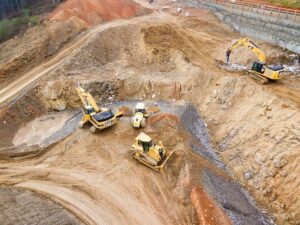Comprehensive Erosion Control Inspection Checklist for Construction Sites in Kentucky
Erosion control inspection is the structured assessment of site conditions and control measures to prevent soil loss, sediment discharge, and stormwater pollution on construction projects. Unchecked erosion undermines foundation stability, triggers regulatory fines, and delays project schedules. This guide delivers a step-by-step erosion control inspection checklist tailored for Kentucky sites, defines core objectives, explains environmental impact, outlines responsible parties, and previews Kentucky regulations, inspection phases, best management practices, documentation workflows, and how Earth Works, LLC’s expertise supports civil works compliance. Readers will gain actionable insights to streamline daily site reviews, meet state requirements, and integrate inspections seamlessly into excavation and grading operations while exploring specialized services for plan development, monitoring, and reporting.
Kentucky Construction Erosion Control Inspection Checklist
Erosion control inspection is a systematic evaluation of sediment and water management measures on active sites to ensure they function as intended and comply with environmental standards. This process prevents soil degradation, minimizes stormwater runoff pollution, and reduces risks of off-site sediment discharge that can lead to costly violations. For example, checking silt fence placement before rainfall protects adjacent waterways from turbidity and sediment-laden flow. By identifying failures early, project managers safeguard soil health and maintain foundation integrity, laying the groundwork for effective regulatory compliance and uninterrupted progress.
Construction professionals undertake inspections to verify that erosion control measures align with design specifications and regulatory guidelines. Regular reviews accelerate corrective actions—such as reinforcing filter fabrics or clearing sediment basins—before minor issues escalate into major erosion events. This proactive stance not only upholds environmental stewardship but also prevents project delays and financial penalties, creating a stable work environment that supports subsequent civil works activities.
What Are the Key Objectives of Erosion and Sediment Control Inspections?
Erosion and sediment control inspections aim to verify that all installed measures effectively intercept runoff, retain soil particles, and channel stormwater safely away from exposed earth. Inspections focus on integrity checks, maintenance needs, and evidence of ponding or overtopping. By systematically assessing barriers, basins, and diversion channels, inspections confirm that sediment remains on site and water quality is protected.
Inspections also evaluate site stability indicators such as revegetation progress, soil compaction, and erosion rill formation. Documenting these observations helps construction teams prioritize remedial actions, optimize resource allocation, and demonstrate due diligence for auditors. Consistent oversight fosters a culture of continuous improvement in sediment control strategies across project phases.
How Does Erosion Control Prevent Stormwater Runoff and Soil Degradation?
Erosion control prevents stormwater runoff by intercepting and slowing down flowing water, allowing suspended soil particles to settle out before water exits the construction boundary. Measures like sediment basins and check dams dissipate flow energy, while silt fences and geotextiles trap fine particles at runoff sources. For instance, a well-maintained sediment basin captures solids and gradually releases clearer water through an outlet structure, preserving downstream channel stability.
By reducing the velocity and volume of runoff, erosion control measures maintain soil structure, promote vegetation establishment, and protect adjacent ecosystems. Stabilized slopes and vegetated buffers absorb rainfall impact and anchor topsoil in place, preventing rill erosion. These combined mechanics support long-term landscape health and minimize environmental footprints associated with earthworks.
Who Should Conduct Erosion Control Inspections on Construction Projects?
General contractors, civil works project managers, and designated environmental compliance officers are best positioned to conduct erosion control inspections because they understand project sequencing, regulatory obligations, and on-site safety protocols. Their direct involvement ensures immediate communication of corrective actions to field crews. In larger operations, dedicated inspectors or third-party specialists provide unbiased assessments and detailed reporting that strengthen compliance records.
Engaging experienced professionals—such as Earth Works, LLC—brings local knowledge of Kentucky regulations, hands-on expertise in ESC plan implementation, and advanced reporting tools. These specialists not only conduct inspections but also develop corrective action plans and track maintenance trends, delivering comprehensive oversight that integrates seamlessly with excavation and grading workflows.
What Are Kentucky’s Environmental Regulations for Erosion Control on Construction Sites?
Kentucky’s environmental regulations mandate that construction sites implement sediment and erosion control measures meeting state and federal stormwater requirements to protect water quality. The Kentucky Division of Water enforces the National Pollutant Discharge Elimination System (NPDES) permit for stormwater, requiring projects disturbing one acre or more to develop and follow a Stormwater Pollution Prevention Plan (SWPPP). This regulatory framework ensures proactive planning and diligent site management.
Non-compliance with state permit conditions can result in administrative orders, monetary penalties, and project shutdowns. For example, failing to inspect controls weekly or after significant rainfall events contradicts permit obligations and can trigger fines exceeding thousands of dollars per day. Understanding these legal implications underscores the importance of robust inspection routines and accurate documentation.
Which State and Federal Agencies Govern Erosion and Sediment Control in Kentucky?
Kentucky’s sediment and erosion control oversight involves the Kentucky Division of Water under the Energy and Environment Cabinet and the United States Environmental Protection Agency’s Region 4 office. The state agency issues NPDES permits, reviews SWPPPs, and conducts site audits. EPA Region 4 provides enforcement guidance, supports state programs, and addresses interstate water quality concerns.
Aligning local procedures with federal expectations ensures that inspection checklists satisfy both Kentucky permit conditions and broader Clean Water Act standards. Collaboration between state and federal regulators drives consistent enforcement and clarifies performance criteria for construction professionals.
What Are the Legal Requirements and Penalties for Non-Compliance?
Legal requirements include developing a SWPPP, conducting weekly inspections plus additional reviews after rainfall exceeding 0.5 inches, maintaining records for at least three years, and implementing corrective measures within 48 hours of identifying deficiencies. Operators must train staff on permit conditions and ensure SWPPP updates reflect site changes.
Penalties for violations range from administrative fines of up to $10,000 per day for serious infractions to stop-work orders that halt grading and excavation. Repeated or egregious non-compliance may lead to civil litigation and reputation damage. Meeting these legal thresholds protects projects from financial and operational setbacks.
How Do Construction Environmental Management Plans (CEMPs) Support Regulatory Compliance?
Construction Environmental Management Plans (CEMPs) translate permit requirements into site-specific protocols that guide erosion control inspections, pollution prevention measures, and emergency responses. A CEMP integrates SWPPP elements with traffic control, waste handling, and habitat protection procedures, creating a unified compliance roadmap.
By embedding inspection checkpoints, maintenance schedules, and documentation workflows within the CEMP, project teams ensure that every control measure—from silt fences to sediment traps—receives consistent oversight. This structured approach fosters accountability, streamlines reporting, and builds a clear audit trail for state and federal regulators.
What Does a Comprehensive Erosion Control Inspection Checklist Include?
A thorough inspection checklist spans pre-construction surveys, continuous monitoring during earthworks, and post-rainfall evaluations to verify that all sediment control measures remain effective. It ensures systematic oversight of site entrances, soil stabilization, drainage structures, and vegetative buffers, enabling project teams to address issues before they escalate.
Checklist phases include:
- Pre-Construction Site Assessment – Verify baseline conditions, erosion risk zones, and SC/WPC installation locations.
- During Earthworks Monitoring – Inspect erosion barriers, sediment basins, diversion channels, and stockpile protection.
- Post-Rainfall Evaluation – Check for overtopping, sediment accumulation, and vegetation damage following storm events.
How Is the Checklist Structured Across Construction Phases?
What Specific Erosion Control Measures Should Be Inspected?
Inspectors verify the functionality of primary erosion control measures, including:
- Silt fences and filter socks for perimeter protection
- Sediment basins and traps for settling suspended solids
- Soil stabilization treatments such as mulching and hydroseeding
- Vegetative buffers to anchor soil and intercept runoff
How to Assess Silt Fence Integrity and Maintenance Needs
Begin by confirming that filter fabric remains free of tears, undermining, and overtopping. Check that support posts are secure and that fence depth in the trench meets regulatory minimums. Remove accumulated sediment once it reaches one-third of the fence height to preserve flow capacity. This practice sustains long-term barrier performance.
This practical field guide is designed to assist those who install, inspect, and maintain best management practices for sediment and erosion control on construction sites.
Field Manual for Sediment and Erosion Control Inspection on Construction Sites
The manual is also valuable for use on construction sites as these individuals install, inspect, and maintain best management practices for sediment and erosion control. The manual is designed to be a practical field guide for contractors and inspectors.
What to Check in Sediment Basin Capacity and Functionality
Measure sediment volume against design capacity and confirm outlet structures are clear of debris. Inspect embankment stability for signs of erosion or seepage. Verify that underdrain systems, if present, discharge at appropriate rates to reduce turbidity. Consistent maintenance of basin features prevents uncontrolled discharges.
Understanding the principles of erosion and sediment control, particularly through the lens of geomorphology, is crucial for effective management on construction sites.
Geomorphology and Erosion Control on Construction Sites
Erosion control on construction sites is a discipline for which relatively few individuals have received formal training. This paper will review the principles of erosion and sediment control on construction sites and discuss the role of geomorphology in understanding and managing these processes. It will also discuss the effectiveness of various erosion and sediment control measures and provide recommendations for their implementation.
How Should Stormwater Drainage and Runoff Controls Be Evaluated?
Inspectors examine inlets, conveyance channels, and diversion berms to ensure unobstructed flow paths and erosion-resistant linings. Check for sediment buildup in culverts and confirm that temporary drainage swales direct runoff into sediment traps. Evaluate the grade and compaction of diversion channel slopes to prevent scour and channel migration.
Detailed evaluation of drainage controls minimizes surface flow velocities, reduces scour risk, and channels runoff into treatment structures. This comprehensive assessment supports both sediment control and site stability throughout construction phases.
What Are Best Management Practices (BMPs) for Effective Erosion and Sediment Control?
Best management practices (BMPs) deliver proactive strategies to minimize erosion and optimize water quality. BMPs combine structural measures—such as erosion blankets and reinforced check dams—with non-structural approaches including phased grading and vegetation planning. This integrated methodology reduces dependency on reactive fixes.
Key BMP categories include:
- Source Control: Limiting exposed soil areas through staged clearing
- Runoff Management: Installing interceptor swales to slow flow
- Pollution Prevention: Implementing spill response protocols
- Post-Construction Stabilization: Reestablishing permanent vegetation
Which BMPs Align with Inspection Checklist Items?
Each checklist item corresponds to a BMP:
- Silt Fence Checks → Source Control Barrier BMP
- Sediment Basin Monitoring → Runoff Treatment BMP
- Soil Stabilization Reviews → Surface Protection BMP
- Vegetation Establishment → Post-Construction Stabilization BMP
How Can Daily and Post-Rainfall Inspections Improve Site Compliance?
Daily inspections confirm that new disturbance areas receive timely barrier installation and that existing controls remain intact. Post-rainfall reviews target damage from recent storm events, verifying that measures handle actual flows and sediment loads. This dual-frequency approach captures emergent issues and tracks maintenance effectiveness over time.
By documenting daily observations and storm-event outcomes, teams build comprehensive records that demonstrate due diligence, streamline corrective workflows, and strengthen audit readiness for state and federal regulators.
What Digital Tools Enhance Erosion Control Inspection and Reporting?
Modern inspection apps allow instant capture of photographs, geotagged location data, and condition notes, feeding directly into centralized reporting platforms. Digital checklists standardize item tracking, alert teams to pending maintenance, and generate timestamped compliance reports. Cloud-based dashboards provide managers with real-time visibility into site performance trends.
Adopting these tools accelerates corrective responses, reduces paperwork errors, and creates a transparent audit trail that underpins environmental compliance and project accountability.
How Should Documentation and Reporting Be Managed for Erosion Control Inspections?
Effective reporting transforms raw inspection data into actionable records that satisfy permit requirements and support corrective workflows. A complete inspection report includes date, inspector name, weather conditions, findings for each control measure, photographic evidence, and recommended actions with completion deadlines. Clear documentation prevents compliance gaps and facilitates communication across teams.
Storing reports in a central repository enables trend analysis—such as sediment accumulation rates or recurring barrier failures—and informs continuous improvement of ESC plans. Accurate record-keeping also strengthens defense in the event of regulatory audits or environmental incidents.
What Are the Essential Elements of an Inspection Report?
A compliant inspection report contains:
- Project identification and permit reference
- Inspection date, time, and person responsible
- Weather summary and recent rainfall metrics
- Detailed condition ratings for each control item
- Photographs illustrating deficiencies and corrective marks
- Action items with assigned personnel and deadlines
How Does Accurate Record-Keeping Prevent Fines and Project Delays?
Maintaining complete inspection logs and action-item closures demonstrates permit adherence to regulators, reducing the likelihood of stop-work notices or financial penalties. Clear documentation expedites issue resolution, preventing minor erosion events from escalating into major site failures that halt earthworks. Consistent records also support efficient project scheduling and resource planning.
By proving due diligence through detailed reports, construction teams build credibility with authorities, avoid costly enforcement actions, and sustain uninterrupted progress toward project milestones.
What Digital Reporting Solutions Support Environmental Compliance?
Cloud-based platforms with mobile inspection modules integrate automatically with SWPPP documents, ensuring that reports update in real time and corrective actions are tracked transparently. Automated reminders prompt inspections after significant rainfall events, while analytics dashboards highlight recurring issues. These solutions streamline audit preparation and minimize administrative burdens, freeing project managers to focus on field operations.
How Does Earth Works, LLC Support Erosion Control Inspections and Civil Works Projects in Kentucky?
Earth Works, LLC provides specialized erosion and sediment control inspection services, combining local regulatory expertise with advanced digital reporting tools. Through comprehensive ESC plan development, routine monitoring, and detailed compliance reporting, the company ensures that construction projects meet state permit requirements and maintain site stability.
Integrating these inspection services with broader excavation and civil works capabilities allows Earth Works to offer a holistic solution—from grading and drainage installation to final site rehabilitation. This end-to-end approach reduces coordination gaps, accelerates corrective actions, and delivers a seamless path from permit planning to project closeout.
What Specialized Services Does Earth Works Provide for Erosion and Sediment Control?
Earth Works delivers:
- Customized ESC plan creation aligned with Kentucky NPDES permits
- Weekly and post-storm erosion control inspections with digital reports
- Soil stabilization treatments including hydroseeding and erosion blankets
- Design and installation of sediment basins, diversion channels, and silt fences
How Does Integration with Civil Works Enhance Project Success?
By coupling erosion control inspections with excavation, grading, and site infrastructure services, Earth Works minimizes handoff delays and ensures that control measures evolve with changing site conditions. Unified project management accelerates maintenance cycles, optimizes resource deployment, and creates a consistent quality standard across earthworks and environmental compliance tasks.
This integrated model reduces rework, controls costs, and aligns site operations with both engineering specifications and environmental regulations.
What Are Examples of Successful Erosion Control Projects by Earth Works?
On a recent roadway expansion in central Kentucky, Earth Works implemented a multi-phase ESC plan that included proactive silt fence staging, real-time digital inspection tracking, and rapid deployment of sediment basins. The project maintained 100% compliance, avoided any permit violations, and completed grading 15% faster than forecast.
Similarly, a commercial site redevelopment benefited from tailored soil stabilization treatments and weekly monitoring, resulting in zero off-site sediment discharge and a seamless final inspection.
What Are the Most Frequently Asked Questions About Erosion Control Inspections?
- How often should erosion control measures be inspected on construction sites?
- What are the main types of erosion control methods used in construction?
- How can construction sites prevent sediment runoff effectively?
- What is included in a Stormwater Pollution Prevention Plan (SWPPP)?
- How do environmental compliance audits impact construction projects?
These questions represent common concerns among contractors and project managers, guiding best practices for inspection frequency, method selection, plan development, and audit readiness. By addressing each point, teams gain clarity on regulatory expectations and operational strategies to maintain compliance.
Regulating sediment and managing stormwater require precise planning, continual oversight, and adaptive measures that evolve with site conditions. A robust inspection checklist, supported by expert services and digital tools, empowers construction professionals in Kentucky to protect soils, preserve water quality, and complete projects on time and within regulatory frameworks.
Kentucky contractors and builders can partner with Earth Works, LLC to leverage local expertise, streamlined ESC plans, and comprehensive inspection services that safeguard projects against erosion risks and compliance pitfalls. By embedding these practices into daily operations, teams foster sustainable construction, reduce environmental impact, and achieve lasting site stability.
Best management practices (BMPs) are essential for preventing or minimizing the discharge of sediment and other pollutants into receiving waters, and their proper implementation is key to avoiding failures in construction sediment control.
Best Management Practices for Failures in Construction Sediment Control
However, many of these failures can be attributed to a lack of proper erosion and sediment controls during construction, or a lack of contractor experience with the installation of porous pavement systems. Best management practices (BMPs) are designed to prevent or minimise the amount of sediment and other pollutants discharged into receiving waters.


